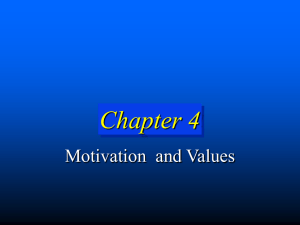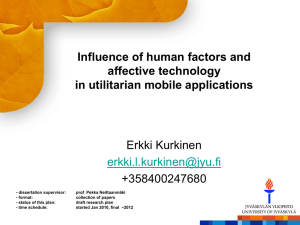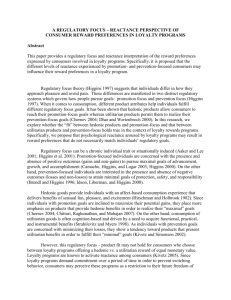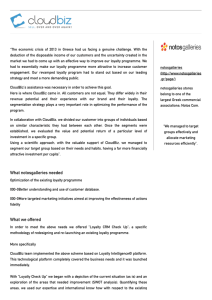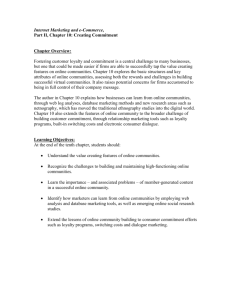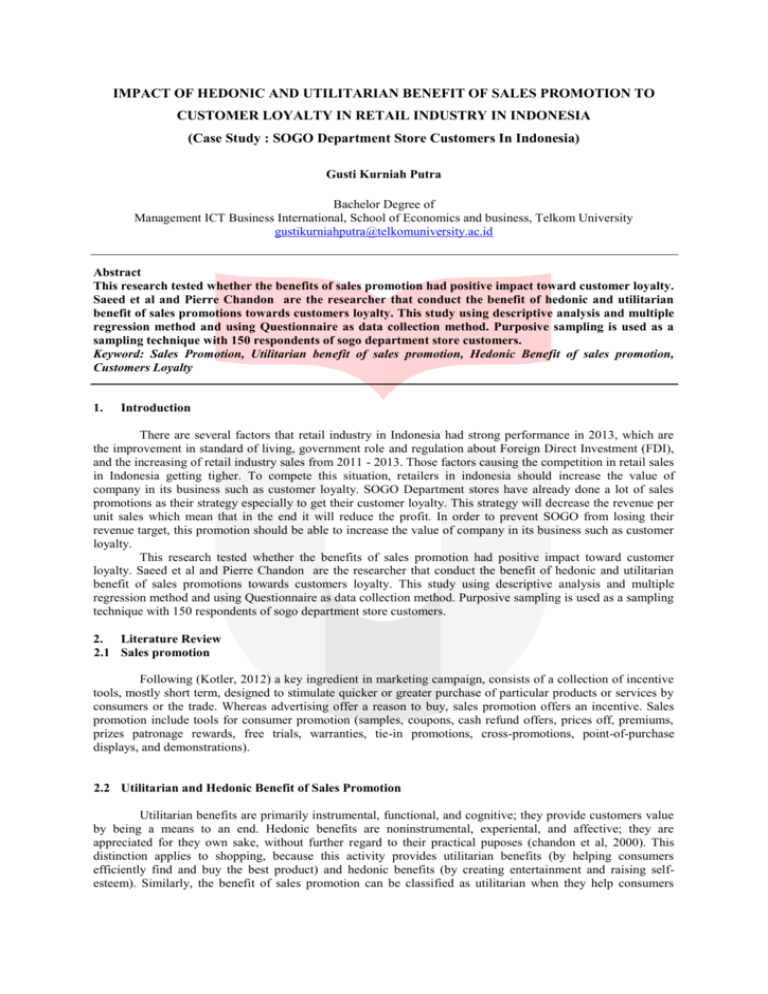
IMPACT OF HEDONIC AND UTILITARIAN BENEFIT OF SALES PROMOTION TO
CUSTOMER LOYALTY IN RETAIL INDUSTRY IN INDONESIA
(Case Study : SOGO Department Store Customers In Indonesia)
Gusti Kurniah Putra
Bachelor Degree of
Management ICT Business International, School of Economics and business, Telkom University
gustikurniahputra@telkomuniversity.ac.id
Abstract
This research tested whether the benefits of sales promotion had positive impact toward customer loyalty.
Saeed et al and Pierre Chandon are the researcher that conduct the benefit of hedonic and utilitarian
benefit of sales promotions towards customers loyalty. This study using descriptive analysis and multiple
regression method and using Questionnaire as data collection method. Purposive sampling is used as a
sampling technique with 150 respondents of sogo department store customers.
Keyword: Sales Promotion, Utilitarian benefit of sales promotion, Hedonic Benefit of sales promotion,
Customers Loyalty
1.
Introduction
There are several factors that retail industry in Indonesia had strong performance in 2013, which are
the improvement in standard of living, government role and regulation about Foreign Direct Investment (FDI),
and the increasing of retail industry sales from 2011 - 2013. Those factors causing the competition in retail sales
in Indonesia getting tigher. To compete this situation, retailers in indonesia should increase the value of
company in its business such as customer loyalty. SOGO Department stores have already done a lot of sales
promotions as their strategy especially to get their customer loyalty. This strategy will decrease the revenue per
unit sales which mean that in the end it will reduce the profit. In order to prevent SOGO from losing their
revenue target, this promotion should be able to increase the value of company in its business such as customer
loyalty.
This research tested whether the benefits of sales promotion had positive impact toward customer
loyalty. Saeed et al and Pierre Chandon are the researcher that conduct the benefit of hedonic and utilitarian
benefit of sales promotions towards customers loyalty. This study using descriptive analysis and multiple
regression method and using Questionnaire as data collection method. Purposive sampling is used as a sampling
technique with 150 respondents of sogo department store customers.
2. Literature Review
2.1 Sales promotion
Following (Kotler, 2012) a key ingredient in marketing campaign, consists of a collection of incentive
tools, mostly short term, designed to stimulate quicker or greater purchase of particular products or services by
consumers or the trade. Whereas advertising offer a reason to buy, sales promotion offers an incentive. Sales
promotion include tools for consumer promotion (samples, coupons, cash refund offers, prices off, premiums,
prizes patronage rewards, free trials, warranties, tie-in promotions, cross-promotions, point-of-purchase
displays, and demonstrations).
2.2 Utilitarian and Hedonic Benefit of Sales Promotion
Utilitarian benefits are primarily instrumental, functional, and cognitive; they provide customers value
by being a means to an end. Hedonic benefits are noninstrumental, experiental, and affective; they are
appreciated for they own sake, without further regard to their practical puposes (chandon et al, 2000). This
distinction applies to shopping, because this activity provides utilitarian benefits (by helping consumers
efficiently find and buy the best product) and hedonic benefits (by creating entertainment and raising selfesteem). Similarly, the benefit of sales promotion can be classified as utilitarian when they help consumers
maximize the utility, efficiency and economy of their shopping and buying and as hedonic when they provide
intrinsic simulation, fun, and self esteem.
Sales promotion can provide consumers with an array of hedonic and utilitarian benefits beyond
monetary savings. Hedonic benefits include value expression,entertainment, and exploration. Along with simple
monetary savings, utilitarian benefits also include product quality and shopping convenience.
Nonmonetary promotions provide more hedonic benefits and fewer utilitarian benefits than monetary
promotions. All benefits except quality contribute to the overall evaluation of monetary and non monetary
promotions. How ever, each type of promotion is primarily evaluated on the basis of the dominant benefits it
provides.
For high-equity brands, sales promotion are more effective when they provide benefits that are
congruent with those provided by product being promoted.specifically, monetary promotions are more effective
for utilitarian products than for hedonic products. Conversely, nonmonetary promotions are relatively more
effective for hedonic products than for utilitarian products (Chandon et al, 2000).
2.3 Customer Loyalty
Customer loyalty is very important for the survival of the company. This is confirmed by Louis Columbus
from Robert Kotler & Keller and Schieffer” stated that "creating loyal customers is at the core of every
business. The concept of customer loyalty is more associated with behavior than with attitude. If someone is a
loyal customer, he showed that purchasing behavior is defined as the purchase of a nonrandom. Nonrandom
term is a loyal customer who has specific prejudices about what to buy and from whom (Griffin 2009).
2.4 Research Framework
This study used eight variables, one dependent variable which is purchase decision process and seven
independent variables of marketing mix elements.
Figure 1. Conceptual Framework
2.5 Hypothesis
According Sekaran (2010) Hypotheses are derived from the theory on which your conceptual model is
based and are often relational in nature. Based on framework that has been illustrated, the hypotheses of this
study are as follows:
H1 :Sales promotion has a positive effect on customers loyalty.
H2 :Utilitarian benefits of sales promotion have positive effect on customers loyalty.
H3 : Hedonic Benefits of sales promotion have positive effect on customers loyalty.
Methodology
2.6 Research Type
In this research, the method that this study used is Quantitative Method, Quantitative research can be
define as research that addresses research objective through empirical assessment that involve numerical
measurement and analysis approaches (Zikmund et al, 2010).The analysis model is Multiple Regression. this
study used multiple regressions because this study used 2 variables for X variable which are utilitarian benefits
and hedonic benefits. this study do not use linear regression because this study have more than one variable and
also this study do not use path analysis because path is used for qualitative method and prediction, and it using
trimming theory for the concept or developing the existing concept.
In accordance also to the previous research, almost all of the method used is descriptive research, which is
quantitative research and the analysis model is by using multiple regression. Regarding to that reason, this study
use also the same method in order to get the result. By using multiple regressions, this study can predict the
value of dependent variable (Y) if there are two or more independent variables.
2.7 Operational Variable
According to (Zikmund et al, 2010), “a variable is anything that nay assume different numerical values; the
empirical assesment of a concept. Meanwhile, according to (Malhotra, 2010), the variable is "a characteristic, a
trait, or an attribute that is measured" which means that the variable is a characteristic, trait, or attribute that is
being measured. Independent variables in this research are two benefits of sales promotion, utilitarian (X1),
hedonic (X2).
According to Sekaran (2010) Dependent variable is the variable of primary interest to the researcher.
Through the analysis of the dependent variable, it is possible to find answers or solution to the problem.
Dependent variable in this research is customers loyalty (Y).
2.8 Measurement Scale
The scale used in this study is ordinal scale. Ordinal scale is a ranking scale in which number are assigned
to objects to indicate the relative extent to which the objects possess some characteristic. Thus it is possible to
determine whether an object has more or less of a characteristic that some other object. (Malhotra, 2010)
In this study, the measurement scale used is a Likert scale. Likert scale is a measurement scale with five
response categories ranging from “strongly disagree” to “strongly agree,” which requires the respondents to
indicate a degree of agreement or disagreement with each of a series of statements related to the stimulus object
(Malhotra, 2010).
2.9
Population and Sampling
Population is not also limited only to the amount present in the object / subject being studied, but all the
characteristics / traits that the subject or object has. Population in this research is all customers of SOGO
Department Store. Non Probability Sampling is used in this study, which is purposive sampling. Convenience
sampling is suitable to be used in this research due to the elements that doesn’t have the same chance to be
selected. Based on Sekaran (2010) in convenience sampling, the most easily accessible members are chosen as
subjects.
2.10 Data Analysis Technique
In this research multiple regression analysis is used as data analysis technique. According to Hair (2010)
multiple regression analysis is a statistical technique used to examine the relationship between a single
dependent variable and a set of independent variables. The ever-widening application of multiple regression fall
into two broad classes of research problem which are prediction and explanation. Prediction involves the extent
to which the regression variate (one or more independent variables) can predict the dependent variable.
3.
Discussion
This study used two variables as the independent variable which are;utilitarian benefit of sales promotion
and utilitarian benefit of sales promotion, and one variable as the dependent variable which is csutomer loyalty.
Table 1
Coefficient Determination
From the results show that the adjusted R square in this research is 0.840. It means that 84% of purchase
decision process are affected by product, price, place, promotion, people, physical evidence and process of
marketing mix. While the rest, which is 16% of purchase decision process are affected by others variable which
are not included in this research.
Table 2
Result of Multiple Linear Regression Analysis
Regression model that can be explained from the results in the form of regression equation as follows:
Y = 0.589X1+ 0.216X2
Those equations can explain as follows:
a. The coefficient regression of utilitarian has positive effect to customer loyalty process
b. The coefficient regression of hedonic has negative effect to customer loyalty process
4.
Conclusion
The results show that: In calculated F value = 77.521 with a significance of 0.000 < 0.05. F value =
77.521 > 4.35 (Ftable), With significant value below 0.05 and the Fvalue > Ftable.T value for utilitarian
benefitis t = 7.990 with significant value 0.000 < 0.05.T value for hedonic benefit is t = 2.019 with significant
value 0.015 < 0.05. The coefficient regression showed utilitarian and hedonic benefit had positive significant
effect to customer loyalty. R.Square value, 0,507, with variant error 0,493. Therefore, if sogo department store
pay attention to the benefit of sales promotion, there will be 50,7% effect.
SOGO department store need to improve the benefit of the sales promotion especially in utilitarian factor
as important factors that effected the customer loyalty. the lowest number of utilitarian benefits variable item is
“i can afford a better-than-usual product”. SOGO department should choose the right product at the right time
so the customers can feel the usefullness of the product that promoted, for example when sogo department store
do the monthly sale they should promoted the hype (new arrival) product so the customers not can feel that they
afford a better than usual product. It will lead into the increasing of customer loyalty.
REFERENCES
Ardianto, Elvinaro. (2010). Metodologi Penelitian untuk Public Relations: Kuantitatif dan Kualitatif.
Bandung: Simbiosa Rekatama Media
Ada Diskon. (2014). Promosi SOGO. (Online). Available at: http://www.adadiskon.com/search.html (25
february 2014)
Babin, Barry J., William R. Darden, and Mitch Griffin (1994), “Work and/Fu: measuring Hedonic and
Utilitarian Shopping Value,”Journal of Consumer Reaserch”.
Badan Pusat Statistik indonesia. (2014). BPS PDB indonesia 2013. (Online). Available at:
http://ekonomi.inilah.com/read/detail/2071210/bps-pdb-triwulan-iv-2013-turun-14 (Online) ( 26
January, 2013)
Case,K.E., & Fair, R.C. (2009). Principles of Economics. (9th edition) USA: Pearson
Chandon, Pierre (2000). A Benefit Congruency Framework of Sales Promotion Effectiveness. UK: London
Chandon, P., Wansink, B. & Laurent, G. (2000). A benefit congruency framework of sales
promotion effectiveness. Journal of Marketing, 64 (4), 65-81.
Cooper, D.R, & Schindler, P.S, (2011) Business Research Methods (11 th edition),
McGraw-Hill
Companies, Inc.
Dodson, J. A., & Taybout. (2001). Impact of Deals and Deal Retraction on Brand Switching. Journal of
Marketing
Research .
GBGIndonesia. (2012). The rise of modern retail outlets. (online). available at:
http://www.gbgindonesia.com/en/services/article/2011/the_rise_of_modern_retail_outlets. php
(Online) (19 February, 2014).
Griffin, J.(2009). Customer Loyalty: how to Earn It, How to Keep it. Australia: John Willey and Sons,Inc
Hair,joseph,F. Black,William, C. Babin, Barry/ Anderson,Rolph. (2010) “Multivariate Data Analysis” .
Newyork: Pearson.
Investinanswer. (2001).Compound Annual Growth Rate. (Online). Available at:
http://www.investinganswers.com/financial-dictionary/investing/compound-annual-growth-rate-cagr1096 (24 february, 2014)
IndonesianCommercialNewsletter. (2011). Perkembangan Bisnis Retail Di Indonesia. (Online). Available at:
http://www.datacon.co.id/Ritel-2011ProfilIndustri.html. (24 February 2014).
Kumar, V., & Shah, D.(2004). Building and Sustaining profitable customer loyalty for 21st
Century. Journal of Retailing
Kotler, P. And Keller, K. (2012). Marketing Management, (14thed.).New Jersey: Prentice Hall
Katalog Promosi. (2014). Promosi SOGO. (Online). Available at:
http://katalogpromosi.com/category/department-store/sogo (24 February 2014)
Kwok, S., Uncles, M. (2005). Sales promotion effectiveness: the impact of consumer differences at an
ethnic-group level // Journal of Product and Brand Management, Vol. 14, No. 3, March.
Maholtra, N,. (2010). Marketing Research. (6thed). New Jersey: Pearson Prentice Hall
MAPI Annual Report, (2009 - 2013). Pt. Mitra Adi Perkasa and Its Entities Annual Report. Company
Annual Report.
Omotayo, Oyenini. (2011). Impact of Sales Promotion on the Consumer Loyalty in the Telecommunication
Industry in Nigeria.
Reuters. (2014). Indonesia's Dec retail sales post highest growth in 5 months. (online).available at:
http://www.reuters.com/article/2014/02/11/indonesia-economy-retail-idUSJ9N0IR01420140211 (24
(online) (24 February, 2014)
Salajegheh, Golpasandbaskiaei (2013). Investigate the Relationship between Promotional and Persuasive
Activities with the amount of Customer Loyalty of Tejarat Bank branches in Bandar-e Abbas.
(online) ) (24 February, 2014)
Schiffman L,. Kanuk L,. (2007). Consumer behaviour (9thed) : New Jersey: Prentice Hall
Seed, R., Nisar, F., Lodhi, R.N., Ahmad, M., & Asyad, H.M.2013.Impact of Sales Promotion
on Consumer Loyalty in The Telecomunication Industry in Pakistan.Journal of Basic and Applied
Scientific Research, 3:5:901-907.
Sekaran, Uma and Roger Bougie. (2010). Research Method for Business: A Skill Building Approach.
Chiches: John Wiley & Sons
Strahilevitz, M. and Myers J. G. (1998) Donations to Charity as Purchase Incentives: How Well They
Work May Depend on What You Are Trying to Sell, Journal of Consumer Research, 24, 4, 434–46.
Sugiyono. (2011). Metode Penelitian Kombinasi (Mixed Methods). Bandung Indonesia : Alfabeta.
Suryamin. (2014). Badan Pusat Statistik (BPS) melaporkan Produk Domestik Bruto (PDB) pada
triwulan IV 2013 mengalami penurunan sebesar 1,42%. (online). Available at:
http://ekonomi.inilah.com/read/detail/2071210/bps-pdb-triwulan-iv-2013-turun-14 (24 February
2014).
Tjahyadi, R.A.2006. Brand Trust Dalam Konteks Loyalitas Merek:Peran Karakterstik Merek, Karakteristik
Perusahaan, Dan Karakteristik Pelanggan-Merek. Management Journal
Trading economics. (2014). Annual GDP of indonesia. (online). available at:
http://www.tradingeconomics.com/indonesia/gdp-growth-annual (Online) (24 February 2014 )
Wiji Sicily Sri Astuti, Erna Wahyuningsih, Endah Winarti (2014). Pengaruh atmosfer toko dan Promosi
Penjualan Terhadap Loyalitas Pelanggan Centro Department Store Di The Plaza Semanggi. (Online)
(24 February 2014 )
Zeithaml, V,. Bitner M,. Gremler D,. Services marketing. (2009). New York: McGraw-Hill.
Zikmund, W G,. Babin B J,. Carr J C,. Griffin M,. (2010). Canada: South-Western, Cengage Learning.



